ALSTOM has announced that it will be joining Engie to develop hydrogen traction for mainline freight duties, based on a generator wagon equipped with a fuel cell that will be able to power electric locomotives away from catenary.
The new system is due enter service from 2025, powering freight trains for mineral water supplier Nestlé Waters and expected to reduce CO2 emissions by 10,000 tonnes year when compared with diesel traction.
Alstom says the generator wagon will be equipped with a high-power fuel cell system running on renewable hydrogen. It will produce current that will be fed to the electric locomotive by means of a power cable, enabling it to operate without an overhead power supply.
Engie will supply the renewable hydrogen “through the deployment of an innovative supply chain,” Alstom says.
The generator wagon will be able to provide all the power required by a main line electric locomotive to haul freight trains on non-electrified routes. This would offer a 100% electric alternative to diesel traction, including on last-mile freight duties, and would be suitable for operations on a national and European scale, Alstom says.
From 2025 Nestlé Waters will deploy the new hydrogen technology to power freight trains carrying mineral water from its bottling plant at Vittel in eastern France to distribution centres in Arles and Montreuil-Bellay, covering a distance of 600km and 760km respectively.
“At Nestlé Waters, we favour rail freight whenever possible,” says Ms Sophie Dubois, CEO of Nestlé Waters in France.
"We are very proud of this project as it represents a significant investment by our railway team to find innovative solutions to answer the climate and environmental challenge.”
“Our ambition is to accelerate the adoption of hydrogen in the rail industry and to develop innovative solutions for the greening of mass transport, including rail freight,” says Mr Marc Granger, chief strategy officer at Alstom.
“We are looking forward to the first operation of a freight locomotive powered by renewable hydrogen in 2025.”

